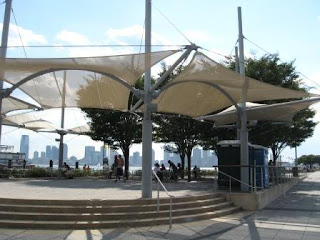Everybody’s been storm-watching for the past 24
hours or so. They all remember Sandy
and, from what the weather reports say, Joaquin is even more powerful. But the wind and rain that’ve battered us
today aren’t his fault: A Nor’easter has
worked its way along this part of the coast.
| Joaquin, as of today...we hope! |
Sandy became a “superstorm” when merged with a Nor’easter before making
landfall near Atlantic City, New Jersey.
It doesn’t seem that Joaquin will do anything like that: He seems content remaining out to sea, well
to the east of Montauk Point. Still, he
could gift our Nor’easter with even more wind and water than it might have
whipped against, and dropped on, us: As
meteorologists tell us, the course of a hurricane is one of the most difficult
things to predict.
There seems to be an interesting divide in how
much concern people who lived through Sandy’s ravages are expressing about the
prospect of another Nor’easter, hurricane or—superstorm?! From what my own
admittedly unscientific observations, the folks on the South Shores of Staten Island and Brooklyn, and in the Rockaways, are bracing themselves. Whether or not they’re making actual
preparations, they are taking the reports and warnings seriously—more
seriously, some admit, than they did when Sandy approached.
On the other hand, residents of Long Beach and
other communities on the South Shore of Nassau County—which, arguably, incurred
even more damage than Brooklyn and at least as much as the Rockaways—seem more
blasé. As one man said, “I lost
everything then. I’m not worried
now.” But people in other devastated
areas also “lost everything”. In fact,
in the Breezy Point area of the Rockaway Peninsula, houses that weren’t blown
apart or washed away burned to the ground when water wreaked havoc with the
electrical wires. I recall seeing people
who were able to retrieve only family photo albums before fleeing, or upon
returning.
As for me:
I am watching the storms. Aside
from not having classes for a week, I wasn’t affected much by Sandy. I want to make sure I can say the same thing
about Joaquin or the Nor’easter.
Then again…Joaquin couldn’t possibly affect us as
much as Sandy did. After all, Joaquin is
a male name, while both males and females are named Sandy. Hell hath no fury like that of both genders,
combined!










